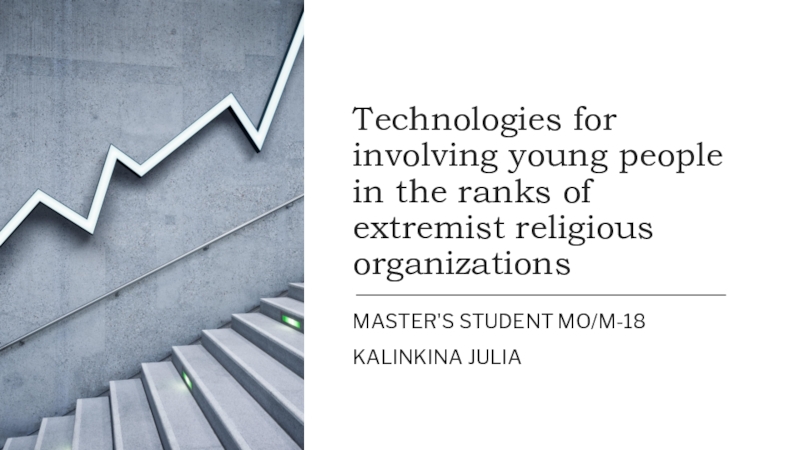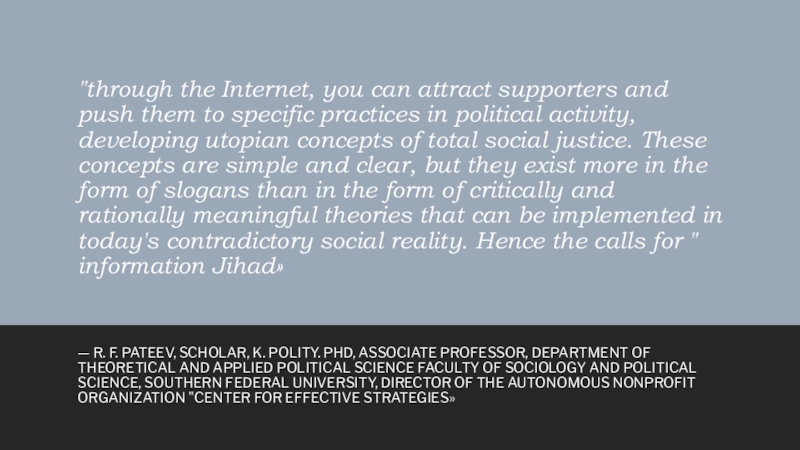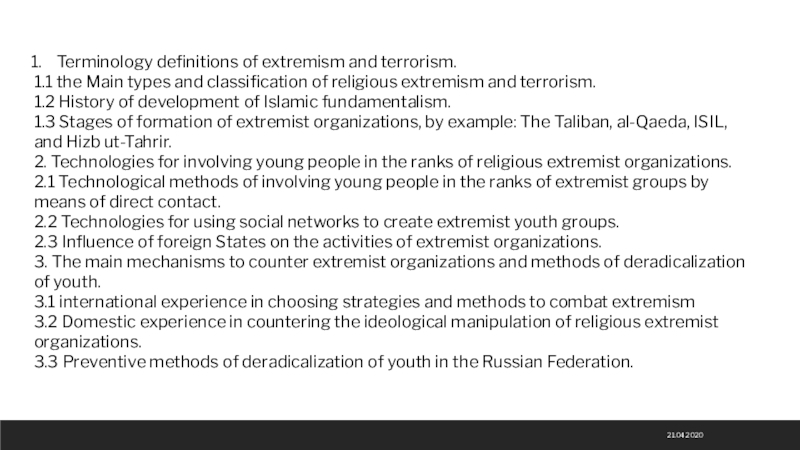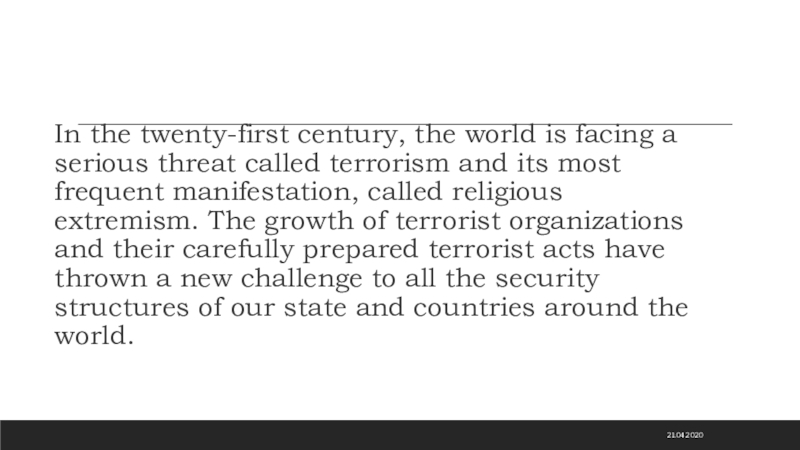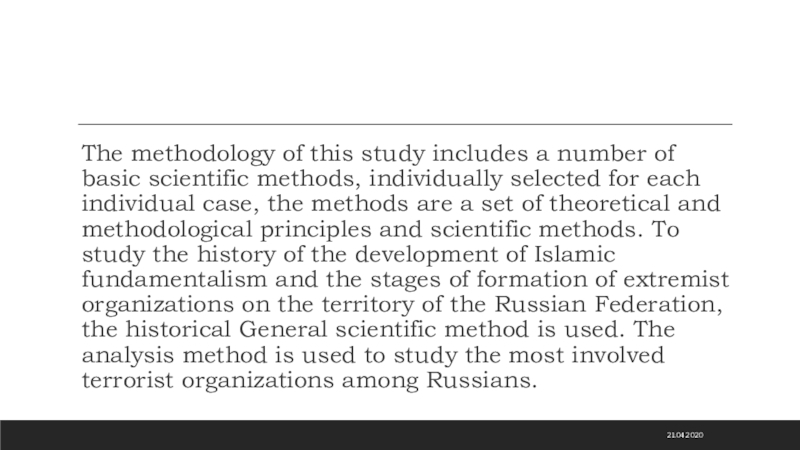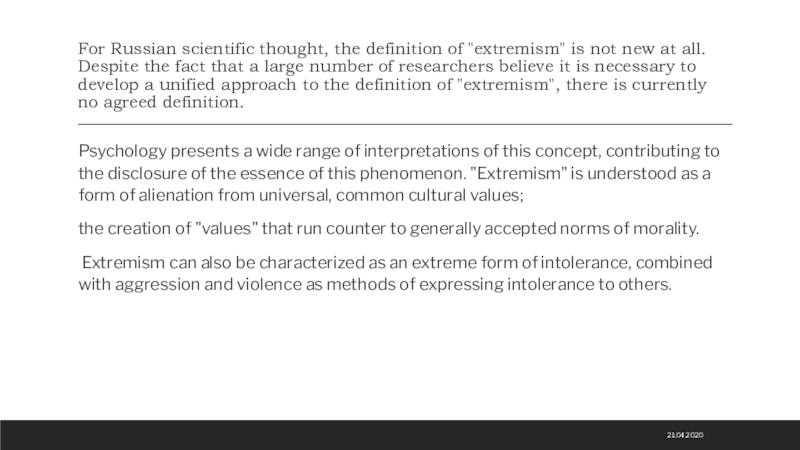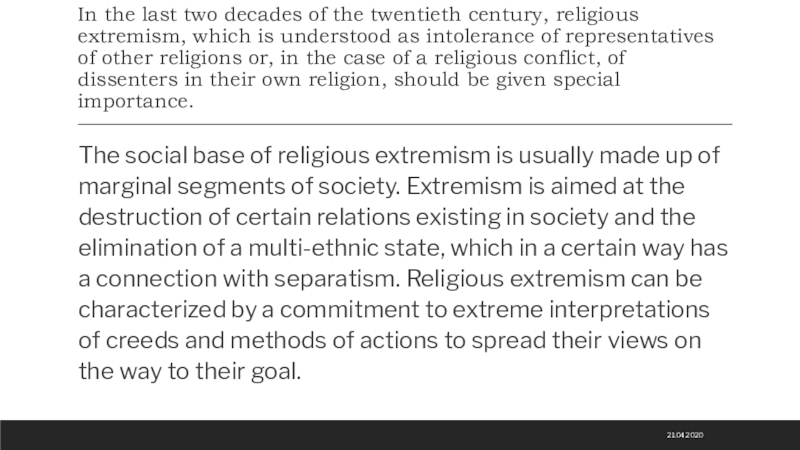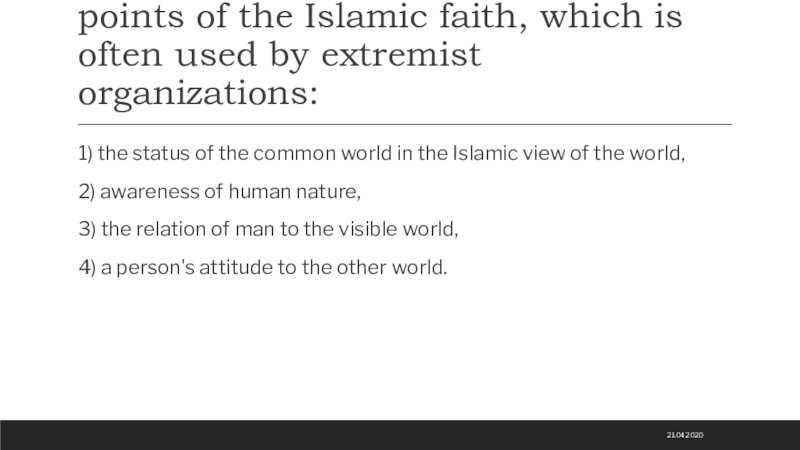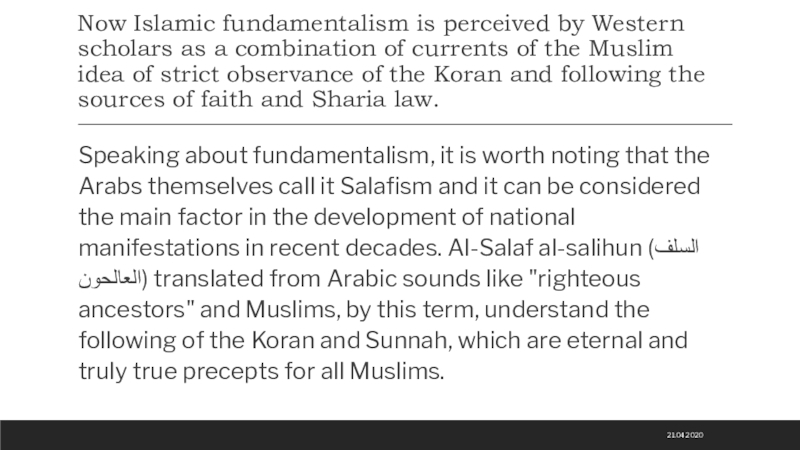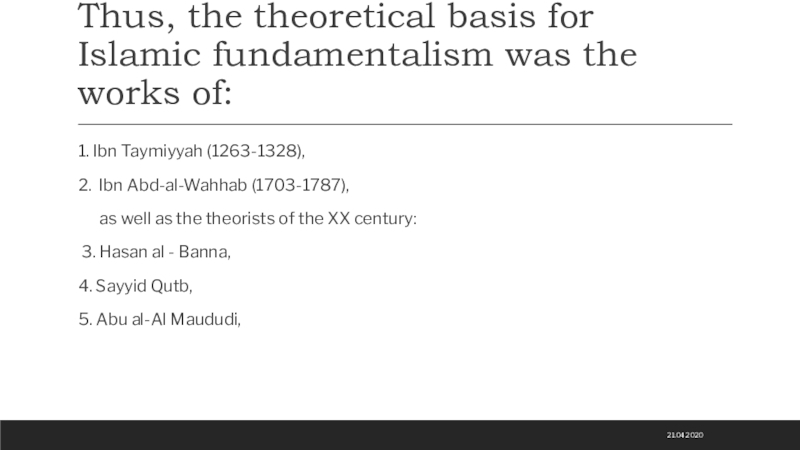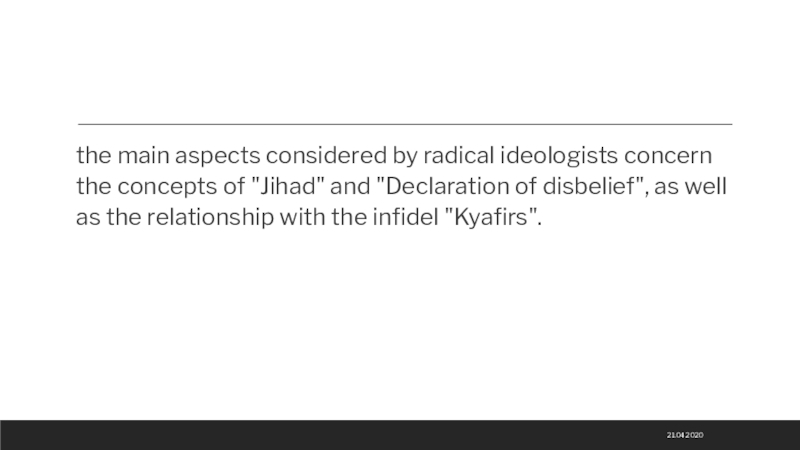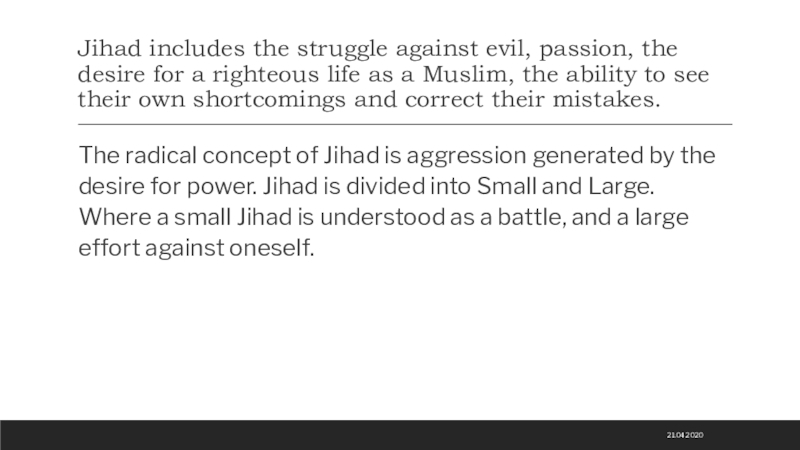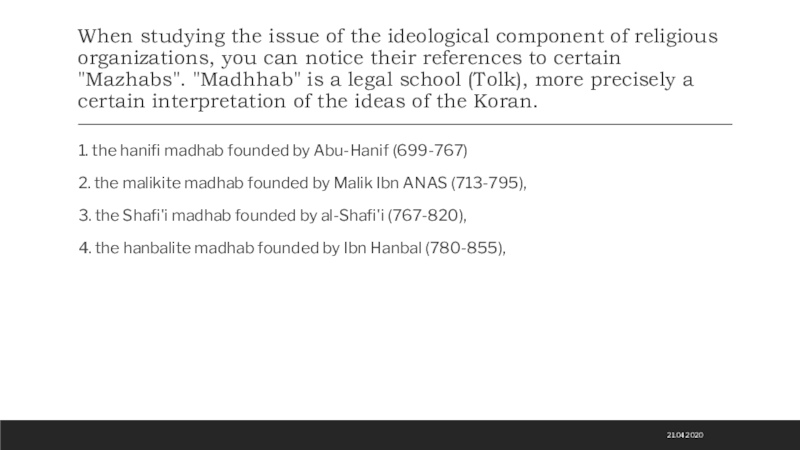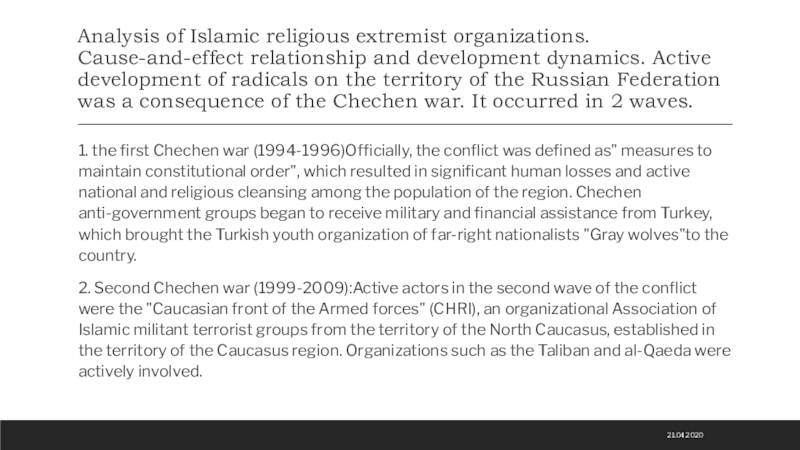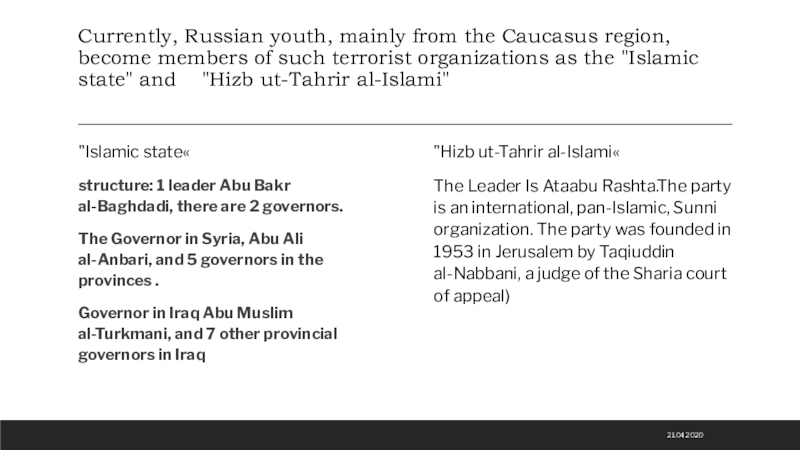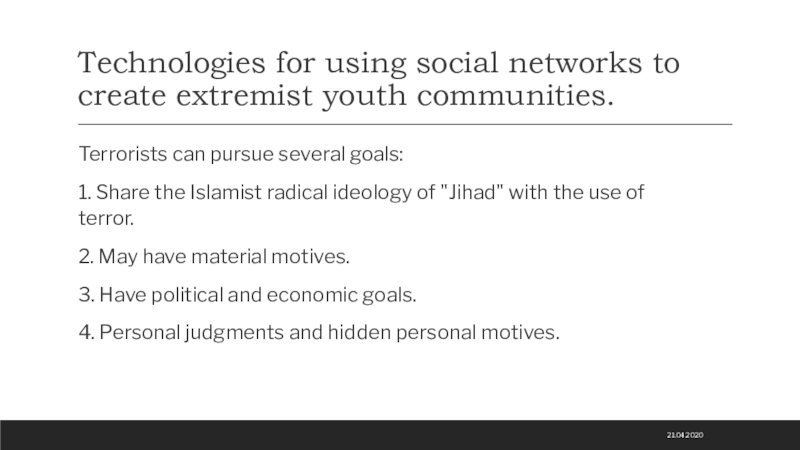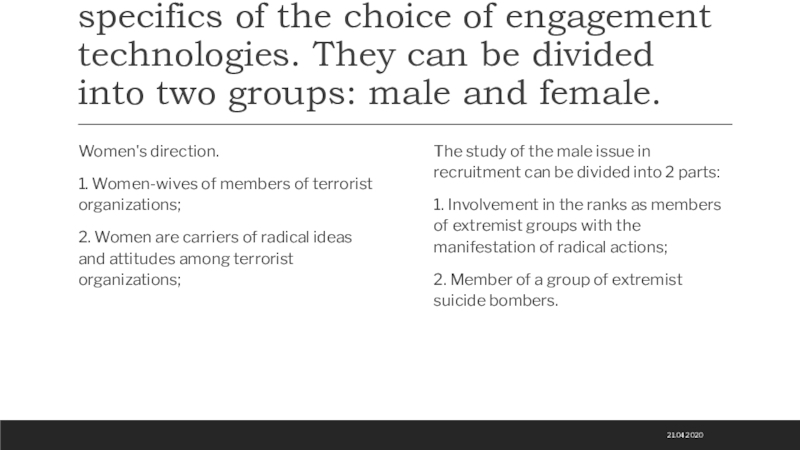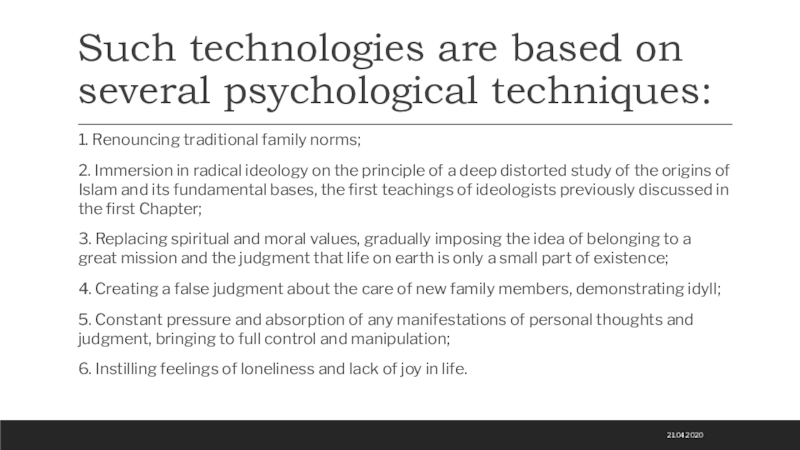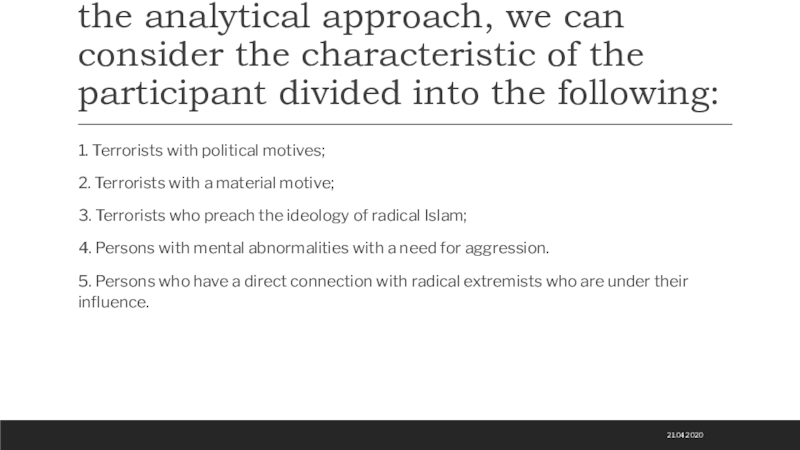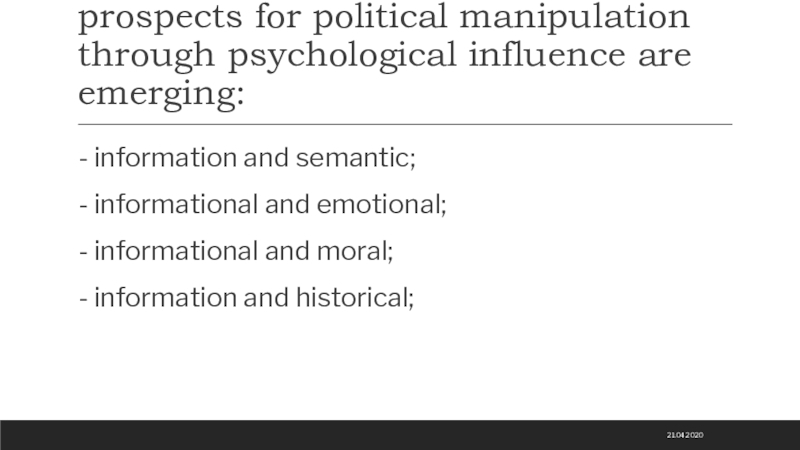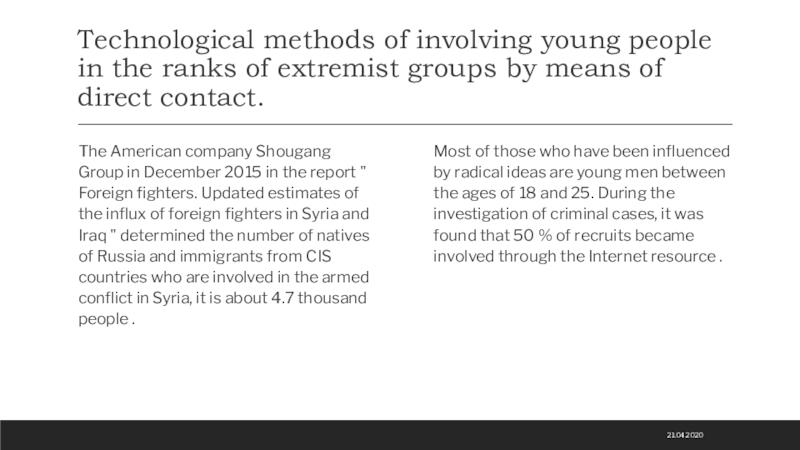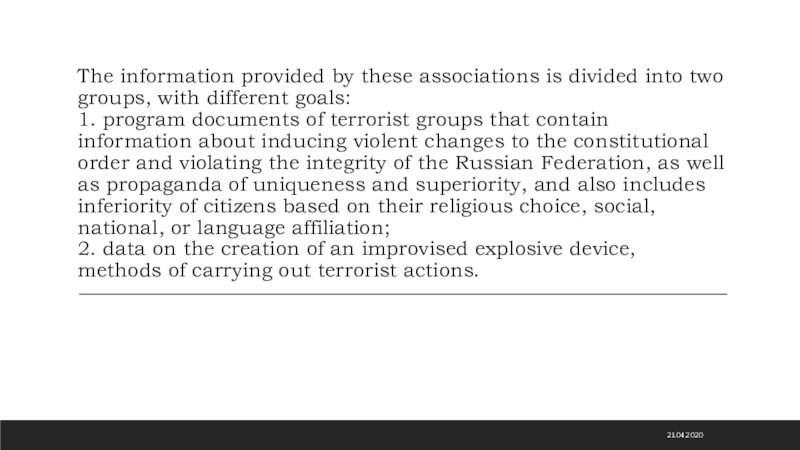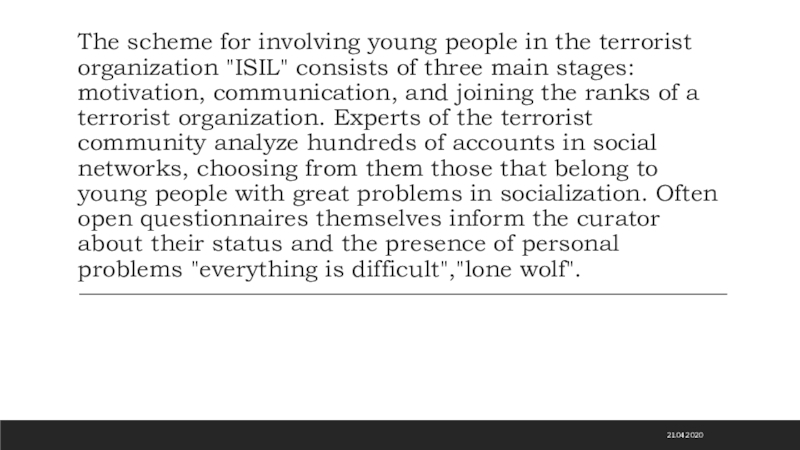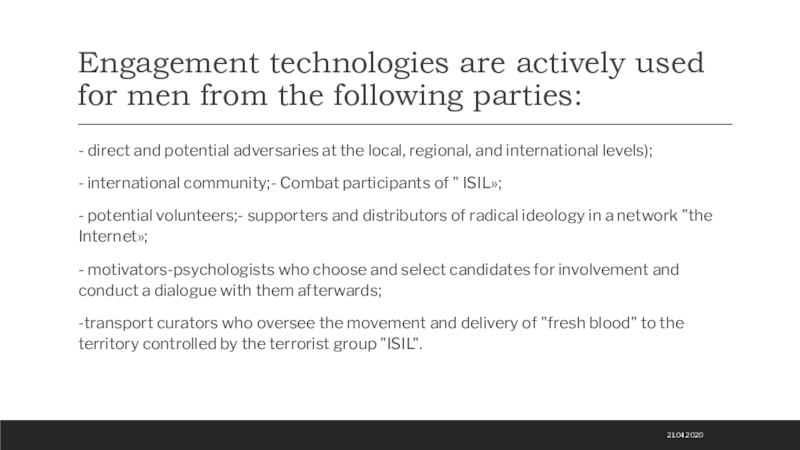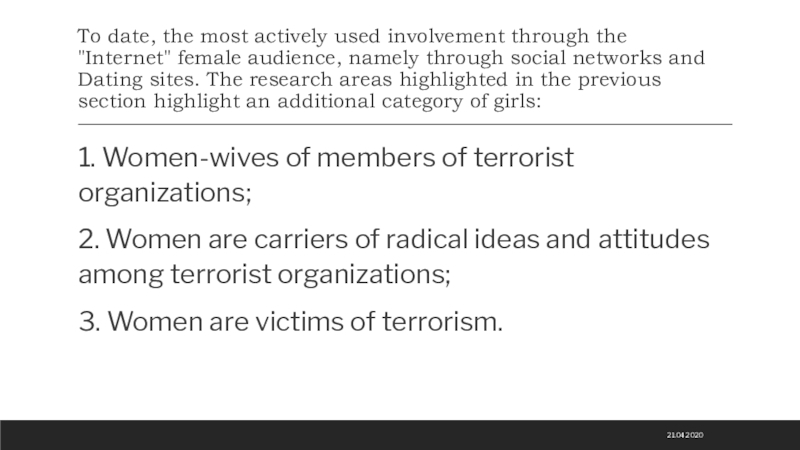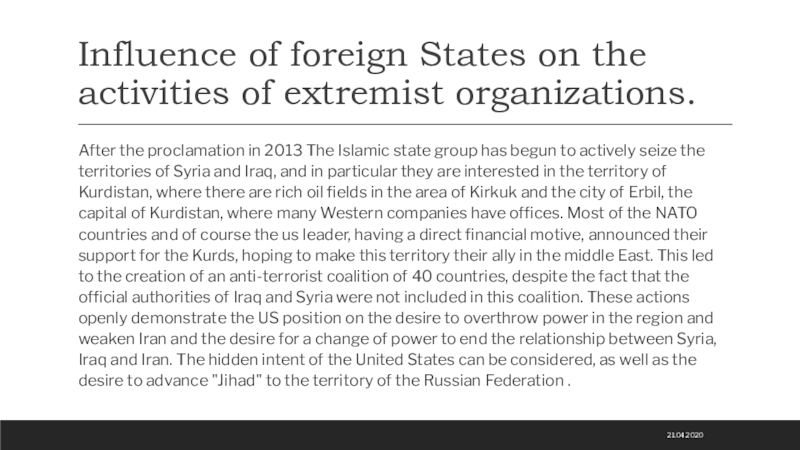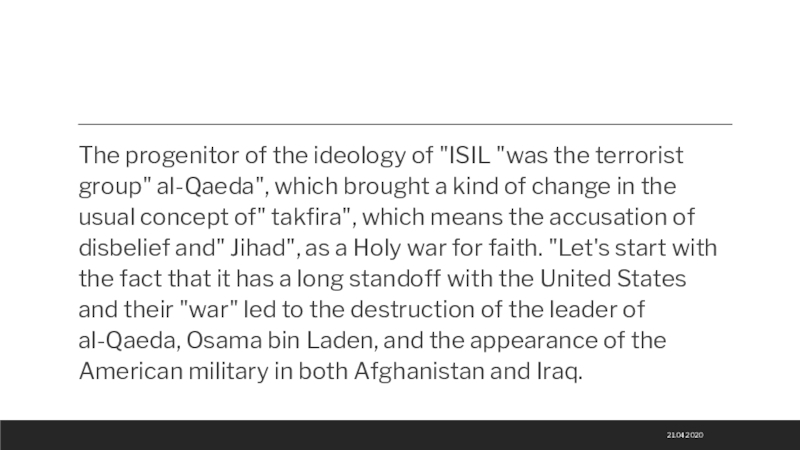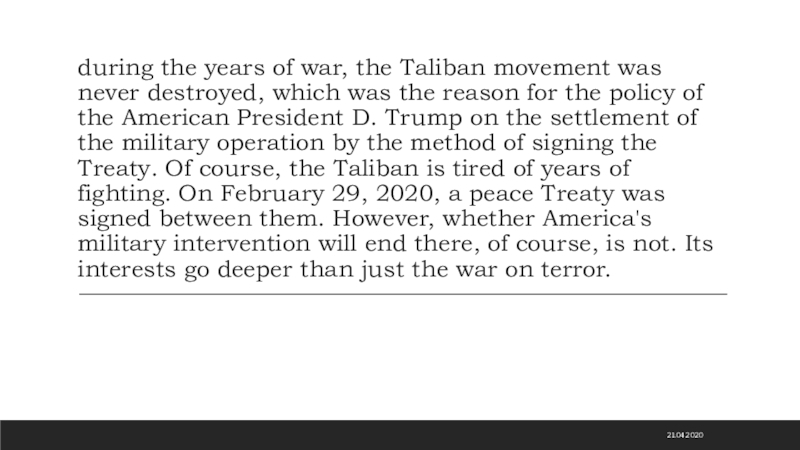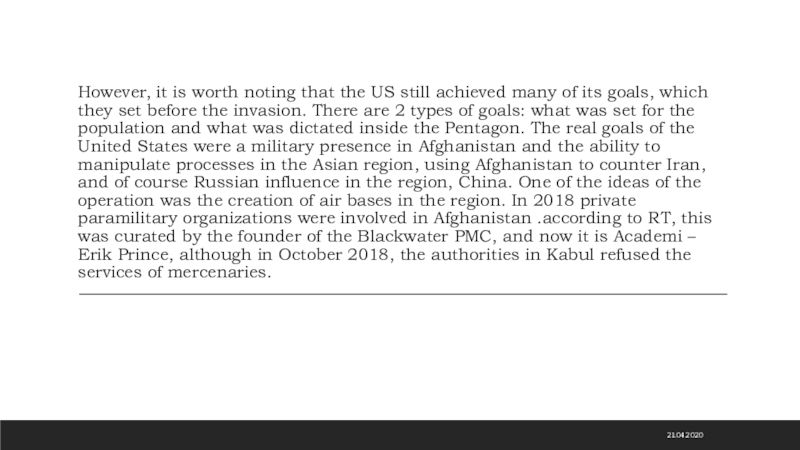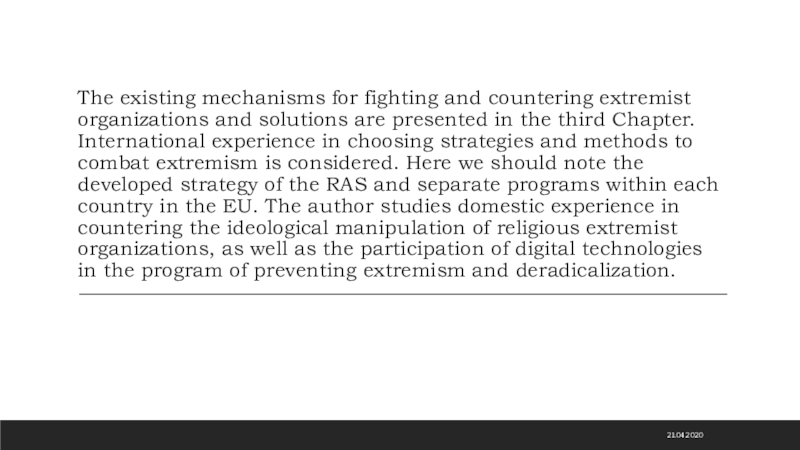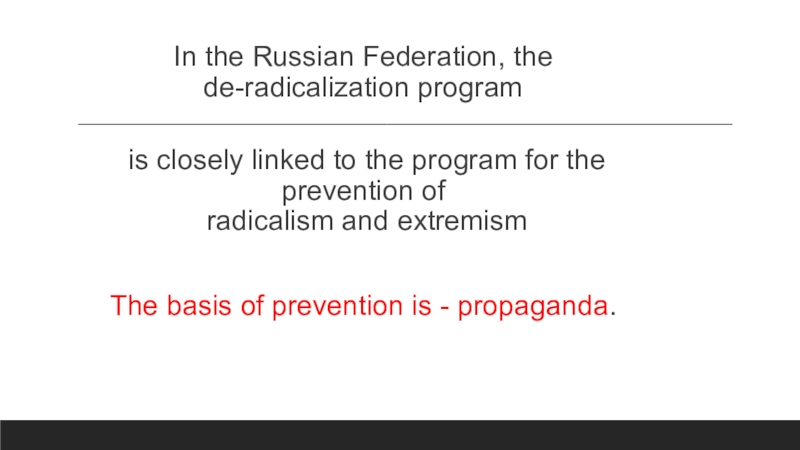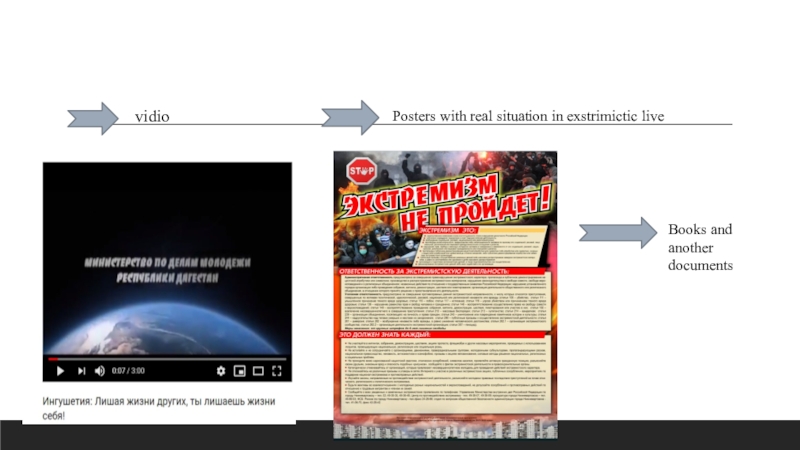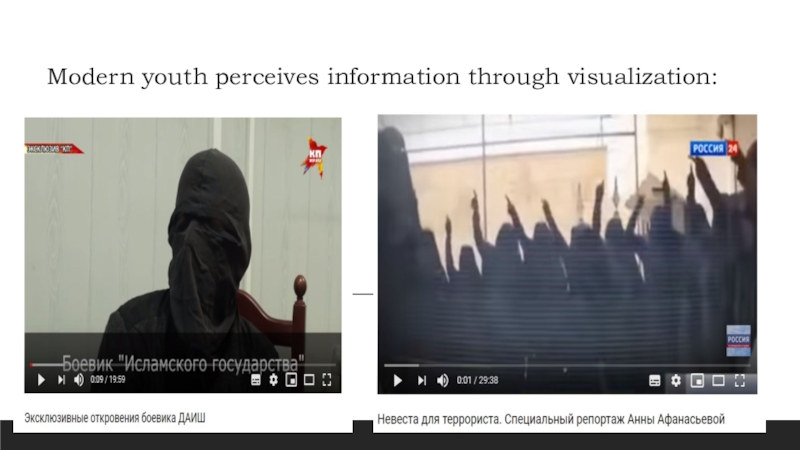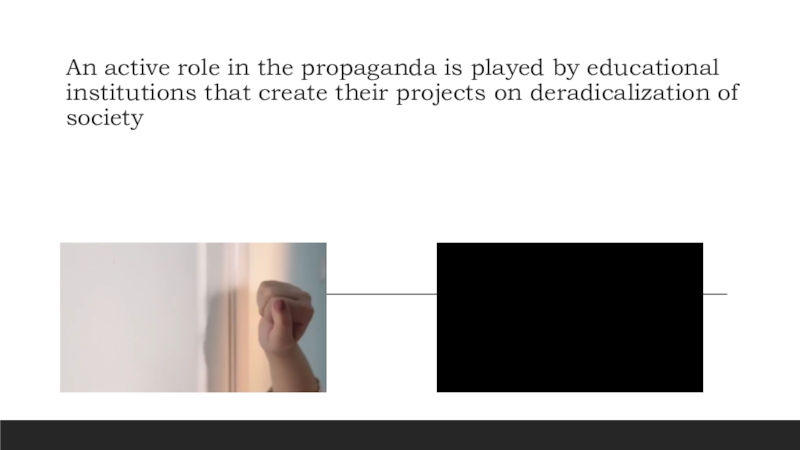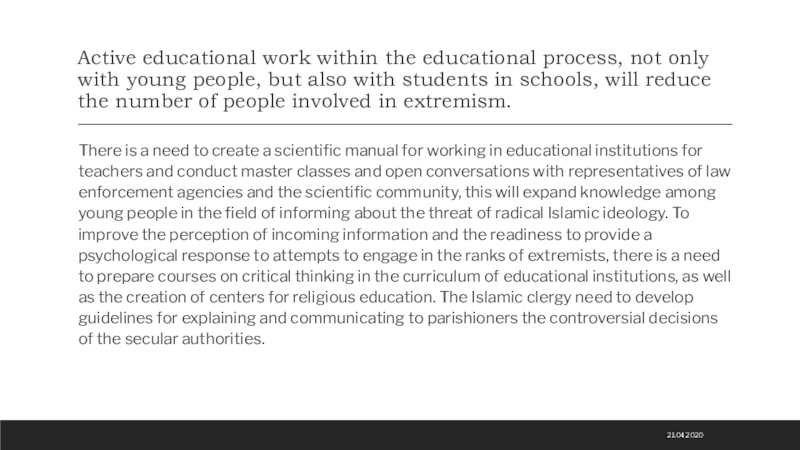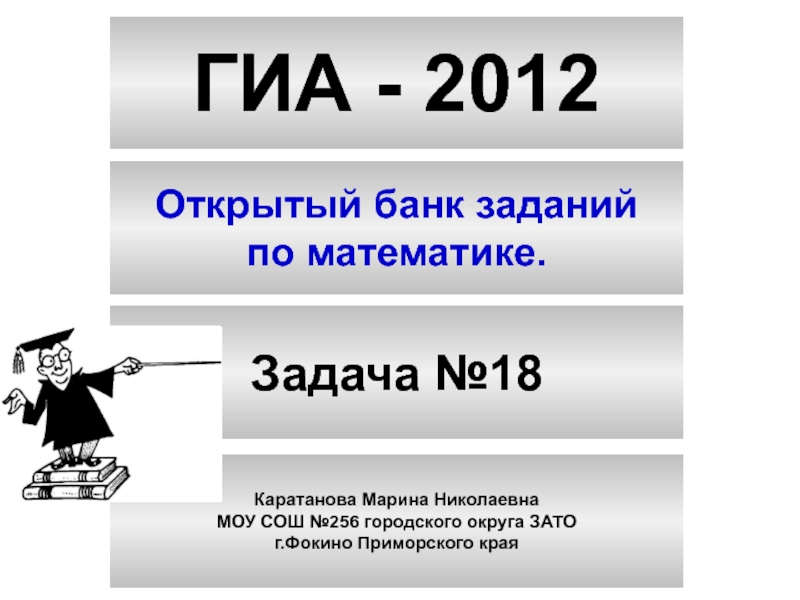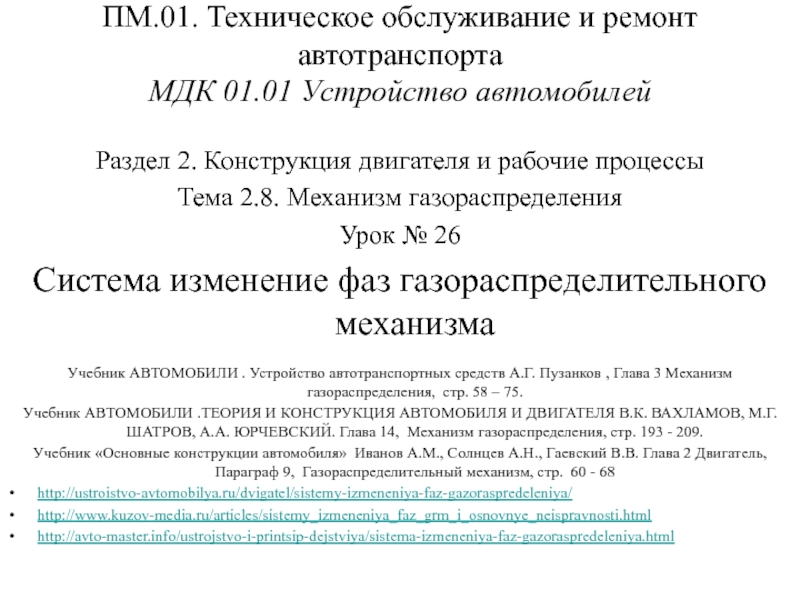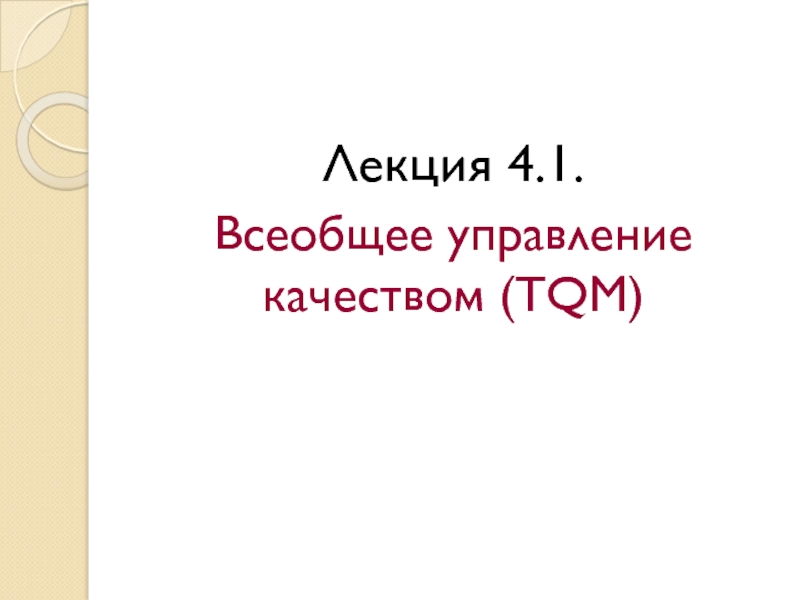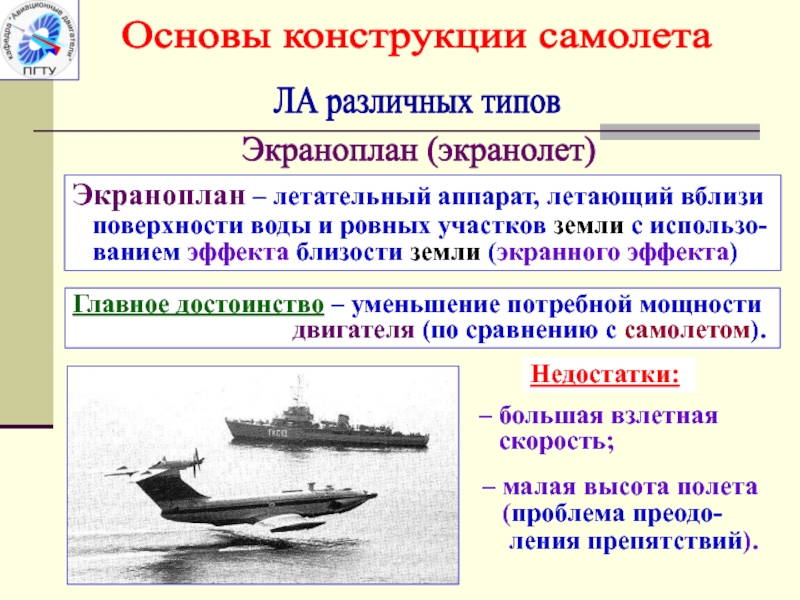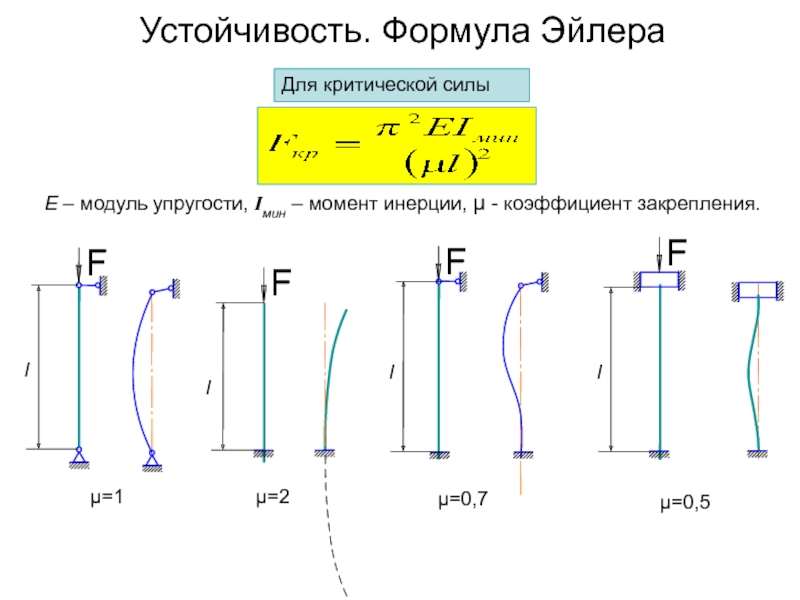Разделы презентаций
- Разное
- Английский язык
- Астрономия
- Алгебра
- Биология
- География
- Геометрия
- Детские презентации
- Информатика
- История
- Литература
- Математика
- Медицина
- Менеджмент
- Музыка
- МХК
- Немецкий язык
- ОБЖ
- Обществознание
- Окружающий мир
- Педагогика
- Русский язык
- Технология
- Физика
- Философия
- Химия
- Шаблоны, картинки для презентаций
- Экология
- Экономика
- Юриспруденция
Technologies for involving young people in the ranks of extremist religious
Содержание
- 1. Technologies for involving young people in the ranks of extremist religious
- 2. "through the Internet, you can attract supporters
- 3. Terminology definitions of extremism and terrorism.1.1 the
- 4. In the twenty-first century, the world is
- 5. The methodology of this study includes a
- 6. For Russian scientific thought, the definition of
- 7. In the last two decades of the
- 8. Considering examples of the use of religious
- 9. Now Islamic fundamentalism is perceived by Western
- 10. Thus, the theoretical basis for Islamic fundamentalism
- 11. the main aspects considered by radical ideologists
- 12. Jihad includes the struggle against evil, passion,
- 13. Of particular significance is the provision on
- 14. When studying the issue of the ideological
- 15. Analysis of Islamic religious extremist organizations. Cause-and-effect
- 16. Currently, Russian youth, mainly from the Caucasus
- 17. Technologies for using social networks to create
- 18. A very important point for research is
- 19. Such technologies are based on several psychological
- 20. However, from the point of view of
- 21. According to the expert of the Ural
- 22. Technological methods of involving young people in
- 23. The information provided by these associations is
- 24. The scheme for involving young people in
- 25. Engagement technologies are actively used for men
- 26. To date, the most actively used involvement
- 27. Influence of foreign States on the activities
- 28. The progenitor of the ideology of "ISIL
- 29. during the years of war, the Taliban
- 30. However, it is worth noting that the
- 31. The existing mechanisms for fighting and countering
- 32. In the Russian Federation, the de-radicalization program
- 33. Counter-narratives : vidioPosters with real situation in exstrimictic liveBooks and another documents
- 34. Modern youth perceives information through visualization:
- 35. Media and social networks play an important role in propaganda.RTRussia 24NTVRussia 1
- 36. An active role in the propaganda is
- 37. To date, there is no single
- 38. Active educational work within the educational process,
- 39. thank you for your attention
- 40. Скачать презентанцию
Слайды и текст этой презентации
Слайд 2"through the Internet, you can attract supporters and push them
to specific practices in political activity, developing utopian concepts of
total social justice. These concepts are simple and clear, but they exist more in the form of slogans than in the form of critically and rationally meaningful theories that can be implemented in today's contradictory social reality. Hence the calls for " information Jihad»— R. F. Pateev, scholar, K. polity. PhD, associate Professor, Department of theoretical and applied political science faculty of sociology and political science, southern Federal University, Director of the Autonomous nonprofit organization "Center for effective strategies»
Слайд 3Terminology definitions of extremism and terrorism.
1.1 the Main types and
classification of religious extremism and terrorism.
1.2 History of development of
Islamic fundamentalism.1.3 Stages of formation of extremist organizations, by example: The Taliban, al-Qaeda, ISIL, and Hizb ut-Tahrir.
2. Technologies for involving young people in the ranks of religious extremist organizations.
2.1 Technological methods of involving young people in the ranks of extremist groups by means of direct contact.
2.2 Technologies for using social networks to create extremist youth groups.
2.3 Influence of foreign States on the activities of extremist organizations.
3. The main mechanisms to counter extremist organizations and methods of deradicalization of youth.
3.1 international experience in choosing strategies and methods to combat extremism
3.2 Domestic experience in countering the ideological manipulation of religious extremist organizations.
3.3 Preventive methods of deradicalization of youth in the Russian Federation.
Слайд 4In the twenty-first century, the world is facing a serious
threat called terrorism and its most frequent manifestation, called religious
extremism. The growth of terrorist organizations and their carefully prepared terrorist acts have thrown a new challenge to all the security structures of our state and countries around the world.Слайд 5The methodology of this study includes a number of basic
scientific methods, individually selected for each individual case, the methods
are a set of theoretical and methodological principles and scientific methods. To study the history of the development of Islamic fundamentalism and the stages of formation of extremist organizations on the territory of the Russian Federation, the historical General scientific method is used. The analysis method is used to study the most involved terrorist organizations among Russians.Слайд 6For Russian scientific thought, the definition of "extremism" is not
new at all. Despite the fact that a large number
of researchers believe it is necessary to develop a unified approach to the definition of "extremism", there is currently no agreed definition.Psychology presents a wide range of interpretations of this concept, contributing to the disclosure of the essence of this phenomenon. "Extremism" is understood as a form of alienation from universal, common cultural values;
the creation of "values" that run counter to generally accepted norms of morality.
Extremism can also be characterized as an extreme form of intolerance, combined with aggression and violence as methods of expressing intolerance to others.
Слайд 7In the last two decades of the twentieth century, religious
extremism, which is understood as intolerance of representatives of other
religions or, in the case of a religious conflict, of dissenters in their own religion, should be given special importance.The social base of religious extremism is usually made up of marginal segments of society. Extremism is aimed at the destruction of certain relations existing in society and the elimination of a multi-ethnic state, which in a certain way has a connection with separatism. Religious extremism can be characterized by a commitment to extreme interpretations of creeds and methods of actions to spread their views on the way to their goal.
Слайд 8Considering examples of the use of religious extremism, we can
characterize a number of basic points of the Islamic faith,
which is often used by extremist organizations:1) the status of the common world in the Islamic view of the world,
2) awareness of human nature,
3) the relation of man to the visible world,
4) a person's attitude to the other world.
Слайд 9Now Islamic fundamentalism is perceived by Western scholars as a
combination of currents of the Muslim idea of strict observance
of the Koran and following the sources of faith and Sharia law.Speaking about fundamentalism, it is worth noting that the Arabs themselves call it Salafism and it can be considered the main factor in the development of national manifestations in recent decades. Al-Salaf al-salihun (السلف العالحون) translated from Arabic sounds like "righteous ancestors" and Muslims, by this term, understand the following of the Koran and Sunnah, which are eternal and truly true precepts for all Muslims.
Слайд 10Thus, the theoretical basis for Islamic fundamentalism was the works
of:
1. Ibn Taymiyyah (1263-1328),
2. Ibn Abd-al-Wahhab (1703-1787),
as
well as the theorists of the XX century:3. Hasan al - Banna,
4. Sayyid Qutb,
5. Abu al-Al Maududi,
Слайд 11the main aspects considered by radical ideologists concern the concepts
of "Jihad" and "Declaration of disbelief", as well as the
relationship with the infidel "Kyafirs".Слайд 12Jihad includes the struggle against evil, passion, the desire for
a righteous life as a Muslim, the ability to see
their own shortcomings and correct their mistakes.The radical concept of Jihad is aggression generated by the desire for power. Jihad is divided into Small and Large. Where a small Jihad is understood as a battle, and a large effort against oneself.
Слайд 13Of particular significance is the provision on Takfir-the accusation of
unbelief, where there is no meaning between non-Muslims and Muslims
who do not live a righteous life-they are called kafirsСлайд 14When studying the issue of the ideological component of religious
organizations, you can notice their references to certain "Mazhabs". "Madhhab"
is a legal school (Tolk), more precisely a certain interpretation of the ideas of the Koran.1. the hanifi madhab founded by Abu-Hanif (699-767)
2. the malikite madhab founded by Malik Ibn ANAS (713-795),
3. the Shafi'i madhab founded by al-Shafi'i (767-820),
4. the hanbalite madhab founded by Ibn Hanbal (780-855),
Слайд 15Analysis of Islamic religious extremist organizations. Cause-and-effect relationship and development
dynamics. Active development of radicals on the territory of the
Russian Federation was a consequence of the Chechen war. It occurred in 2 waves.1. the first Chechen war (1994-1996)Officially, the conflict was defined as" measures to maintain constitutional order", which resulted in significant human losses and active national and religious cleansing among the population of the region. Chechen anti-government groups began to receive military and financial assistance from Turkey, which brought the Turkish youth organization of far-right nationalists "Gray wolves"to the country.
2. Second Chechen war (1999-2009):Active actors in the second wave of the conflict were the "Caucasian front of the Armed forces" (CHRI), an organizational Association of Islamic militant terrorist groups from the territory of the North Caucasus, established in the territory of the Caucasus region. Organizations such as the Taliban and al-Qaeda were actively involved.
Слайд 16Currently, Russian youth, mainly from the Caucasus region, become members
of such terrorist organizations as the "Islamic state" and
"Hizb ut-Tahrir al-Islami""Islamic state«
structure: 1 leader Abu Bakr al-Baghdadi, there are 2 governors.
The Governor in Syria, Abu Ali al-Anbari, and 5 governors in the provinces .
Governor in Iraq Abu Muslim al-Turkmani, and 7 other provincial governors in Iraq
"Hizb ut-Tahrir al-Islami«
The Leader Is Ataabu Rashta.The party is an international, pan-Islamic, Sunni organization. The party was founded in 1953 in Jerusalem by Taqiuddin al-Nabbani, a judge of the Sharia court of appeal)
Слайд 17Technologies for using social networks to create extremist youth communities.
Terrorists
can pursue several goals:
1. Share the Islamist radical ideology of
"Jihad" with the use of terror.2. May have material motives.
3. Have political and economic goals.
4. Personal judgments and hidden personal motives.
Слайд 18A very important point for research is the choice of
ways to engage, here it is worth noting the importance
of the specifics of the choice of engagement technologies. They can be divided into two groups: male and female.Women's direction.
1. Women-wives of members of terrorist organizations;
2. Women are carriers of radical ideas and attitudes among terrorist organizations;
The study of the male issue in recruitment can be divided into 2 parts:
1. Involvement in the ranks as members of extremist groups with the manifestation of radical actions;
2. Member of a group of extremist suicide bombers.
Слайд 19Such technologies are based on several psychological techniques:
1. Renouncing traditional
family norms;
2. Immersion in radical ideology on the principle of
a deep distorted study of the origins of Islam and its fundamental bases, the first teachings of ideologists previously discussed in the first Chapter;3. Replacing spiritual and moral values, gradually imposing the idea of belonging to a great mission and the judgment that life on earth is only a small part of existence;
4. Creating a false judgment about the care of new family members, demonstrating idyll;
5. Constant pressure and absorption of any manifestations of personal thoughts and judgment, bringing to full control and manipulation;
6. Instilling feelings of loneliness and lack of joy in life.
Слайд 20However, from the point of view of the analytical approach,
we can consider the characteristic of the participant divided into
the following:1. Terrorists with political motives;
2. Terrorists with a material motive;
3. Terrorists who preach the ideology of radical Islam;
4. Persons with mental abnormalities with a need for aggression.
5. Persons who have a direct connection with radical extremists who are under their influence.
Слайд 21According to the expert of the Ural Association "Center for
ethno-confessional research, prevention of extremism and counteraction to the ideology
of terrorism" N. S. Sedykh, new prospects for political manipulation through psychological influence are emerging:- information and semantic;
- informational and emotional;
- informational and moral;
- information and historical;
Слайд 22Technological methods of involving young people in the ranks of
extremist groups by means of direct contact.
The American company Shougang
Group in December 2015 in the report " Foreign fighters. Updated estimates of the influx of foreign fighters in Syria and Iraq " determined the number of natives of Russia and immigrants from CIS countries who are involved in the armed conflict in Syria, it is about 4.7 thousand people .Most of those who have been influenced by radical ideas are young men between the ages of 18 and 25. During the investigation of criminal cases, it was found that 50 % of recruits became involved through the Internet resource .
Слайд 23The information provided by these associations is divided into two
groups, with different goals: 1. program documents of terrorist groups that
contain information about inducing violent changes to the constitutional order and violating the integrity of the Russian Federation, as well as propaganda of uniqueness and superiority, and also includes inferiority of citizens based on their religious choice, social, national, or language affiliation; 2. data on the creation of an improvised explosive device, methods of carrying out terrorist actions.Слайд 24The scheme for involving young people in the terrorist organization
"ISIL" consists of three main stages: motivation, communication, and joining
the ranks of a terrorist organization. Experts of the terrorist community analyze hundreds of accounts in social networks, choosing from them those that belong to young people with great problems in socialization. Often open questionnaires themselves inform the curator about their status and the presence of personal problems "everything is difficult","lone wolf".Слайд 25Engagement technologies are actively used for men from the following
parties:
- direct and potential adversaries at the local, regional, and
international levels);- international community;- Combat participants of " ISIL»;
- potential volunteers;- supporters and distributors of radical ideology in a network "the Internet»;
- motivators-psychologists who choose and select candidates for involvement and conduct a dialogue with them afterwards;
-transport curators who oversee the movement and delivery of "fresh blood" to the territory controlled by the terrorist group "ISIL".
Слайд 26To date, the most actively used involvement through the "Internet"
female audience, namely through social networks and Dating sites. The
research areas highlighted in the previous section highlight an additional category of girls:1. Women-wives of members of terrorist organizations;
2. Women are carriers of radical ideas and attitudes among terrorist organizations;
3. Women are victims of terrorism.
Слайд 27Influence of foreign States on the activities of extremist organizations.
After
the proclamation in 2013 The Islamic state group has begun
to actively seize the territories of Syria and Iraq, and in particular they are interested in the territory of Kurdistan, where there are rich oil fields in the area of Kirkuk and the city of Erbil, the capital of Kurdistan, where many Western companies have offices. Most of the NATO countries and of course the us leader, having a direct financial motive, announced their support for the Kurds, hoping to make this territory their ally in the middle East. This led to the creation of an anti-terrorist coalition of 40 countries, despite the fact that the official authorities of Iraq and Syria were not included in this coalition. These actions openly demonstrate the US position on the desire to overthrow power in the region and weaken Iran and the desire for a change of power to end the relationship between Syria, Iraq and Iran. The hidden intent of the United States can be considered, as well as the desire to advance "Jihad" to the territory of the Russian Federation .Слайд 28The progenitor of the ideology of "ISIL "was the terrorist
group" al-Qaeda", which brought a kind of change in the
usual concept of" takfira", which means the accusation of disbelief and" Jihad", as a Holy war for faith. "Let's start with the fact that it has a long standoff with the United States and their "war" led to the destruction of the leader of al-Qaeda, Osama bin Laden, and the appearance of the American military in both Afghanistan and Iraq.Слайд 29during the years of war, the Taliban movement was never
destroyed, which was the reason for the policy of the
American President D. Trump on the settlement of the military operation by the method of signing the Treaty. Of course, the Taliban is tired of years of fighting. On February 29, 2020, a peace Treaty was signed between them. However, whether America's military intervention will end there, of course, is not. Its interests go deeper than just the war on terror.Слайд 30However, it is worth noting that the US still achieved
many of its goals, which they set before the invasion.
There are 2 types of goals: what was set for the population and what was dictated inside the Pentagon. The real goals of the United States were a military presence in Afghanistan and the ability to manipulate processes in the Asian region, using Afghanistan to counter Iran, and of course Russian influence in the region, China. One of the ideas of the operation was the creation of air bases in the region. In 2018 private paramilitary organizations were involved in Afghanistan .according to RT, this was curated by the founder of the Blackwater PMC, and now it is Academi – Erik Prince, although in October 2018, the authorities in Kabul refused the services of mercenaries.Слайд 31The existing mechanisms for fighting and countering extremist organizations and
solutions are presented in the third Chapter. International experience in
choosing strategies and methods to combat extremism is considered. Here we should note the developed strategy of the RAS and separate programs within each country in the EU. The author studies domestic experience in countering the ideological manipulation of religious extremist organizations, as well as the participation of digital technologies in the program of preventing extremism and deradicalization.Слайд 32In the Russian Federation, the de-radicalization program
is closely linked
to the program for the prevention of
radicalism and extremism
The
basis of prevention is - propaganda. Слайд 33Counter-narratives :
vidio
Posters with real situation in exstrimictic live
Books and another
documents
Слайд 36An active role in the propaganda is played by educational
institutions that create their projects on deradicalization of society
Слайд 37 To date, there is no single and universal strategy that
could solve all the problems in the fight against radicalism,
however, collecting bit by bit successful experience a successful combination is possible that will create the right decisions.Слайд 38Active educational work within the educational process, not only with
young people, but also with students in schools, will reduce
the number of people involved in extremism.There is a need to create a scientific manual for working in educational institutions for teachers and conduct master classes and open conversations with representatives of law enforcement agencies and the scientific community, this will expand knowledge among young people in the field of informing about the threat of radical Islamic ideology. To improve the perception of incoming information and the readiness to provide a psychological response to attempts to engage in the ranks of extremists, there is a need to prepare courses on critical thinking in the curriculum of educational institutions, as well as the creation of centers for religious education. The Islamic clergy need to develop guidelines for explaining and communicating to parishioners the controversial decisions of the secular authorities.
